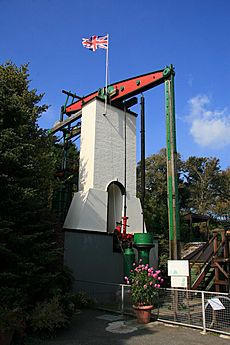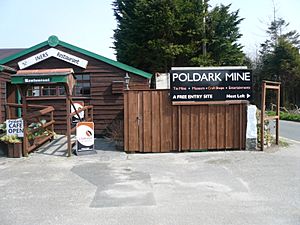Poldark Mine facts for kids
|
Formerly
|
Wendron Forge, Ha'penny Park |
|---|---|
| Industry | tourism |
| Founded | 1972 |
| Founder | Peter Young |
Poldark Mine is a fun place to visit near Helston in Cornwall, England. It's part of a special area called the Cornwall and West Devon Mining Landscape World Heritage Site. This means it's a very important historical place!
At Poldark Mine, you can go on guided tours deep underground into old tin mine tunnels. There's also a museum that shows how people lived and worked in Cornwall long ago. You can see old mining tools and learn about the area's history. The site also has beautiful riverside gardens.
The mine first opened in 1972 as Wendron Forge. Later, it was called Ha'penny Park. When an old tin mine was found there, it was renamed after the famous Poldark books by Winston Graham. The mine also got its name from the BBC TV show that started in 1975.
A historian named A. K. Hamilton Jenkin, who knew a lot about Cornish mining, studied the mine. He believed it was an old mine called Wheal Roots, which was active in the 1700s.
The first owner, Peter Young, sold Poldark Mine in 1988. After that, it had two more owners and became less popular. In 2014, it faced financial trouble again. David Edwards, who had worked with other historical sites like the Ffestiniog Railway in Wales, bought it. He wanted to keep Poldark Mine open as a museum and heritage center. However, in September 2022, it was reported that the mine had been closed for three years. This was because Mr. Edwards had not paid rent for the underground parts of the attraction. As of August 2025, the mine remains closed.
Contents
History of the Tourist Spot
How it Started
The museum and mine we know as Poldark Mine began in 1966. Peter Young, a Royal Marine, bought a local blacksmith's shop called Wendron Forge. He bought it at an auction while on a weekend break.
Soon, Peter bought about three acres of land next to the forge. This land had an old furniture store that used to be a dairy. It was also part of the old Wendron Consols mine. For the next few years, Peter bought and fixed old farm and factory machines. He also planned to sell etchings he made himself.
The site opened to visitors in June 1971 as Wendron Forge. The ground, which often flooded, was raised. New buildings were put up, and about six working machines were set up for people to see.
In 1972, a large machine called a 30-inch beam engine was brought to the site. This engine came from a deserted village called Greensplat. It used to pump 500 gallons of china clay slurry every minute from 240 feet deep! It was the last engine of its kind to work in Cornwall, stopping in 1959.
The engine was built in 1850 for the Bunny tin mine. It took eight months in 1972 for a team of volunteers to set it up at Poldark Mine. By spring 1973, the engine was working using compressed air.
In the 1980s, the attraction changed its name to "Ha'penny Park."
After Peter Young Left
Peter and Jose Young moved to Spain and sold Poldark Mine to John McLeod. He ran it until it faced financial difficulties in 1999. In 2000, a company started by Richard Williams bought the property. He worked hard to make it one of the most exciting underground mine experiences in Europe.
At this time, one of the popular things to do was Evening 'Ghost Tours'. The site was also allowed to hold weddings. It even had a special link with the Llywernog Silver-Lead Mine in Wales.
After Richard Williams passed away in 2012, fewer people visited the mine. It again faced financial trouble in 2014. The property was put up for sale that year. David Edwards, who had worked with the Ffestiniog Railway and the Llechwedd Slate Caverns in Wales, bought it. Work to fix and restore the mine started right away. It reopened in May 2014. As mentioned, the mine has been closed since around September 2019.
How Tin Was Mined Here Long Ago
The Poldark Mine site is in the valley of the River Cober. This area was once very rich in tin ore. Over a very long time, rocks above the ground wore away. These rocks contained many veins of tin. Small pieces of the heavy tin ore collected in the river's gravel and sand. This created rich tin deposits close to the surface in most of the river valleys.
We know that people started finding and processing this tin a very long time ago. Near the entrance to Poldark Mine is the Trenear Mortar Stone. This is a large rock with at least 17 hollows on its top. People would have crushed tin ore by hand in these hollows using other stones. We can't say exactly when it was used, but experts think it was during the later prehistoric period (around 2000 BC to 43 AD). It's the only known stone like this in south-west England. It was made a special protected monument in 2009.
The first machine for crushing tin, called a tin stamping mill, was recorded in this area in 1493. It was on land owned by the Duchy of Cornwall. By 1650, there were more industrial buildings at Trenere Wolas (now Lower Trenear). These included a crazing-mill, two stamping-mills, and a blowing house (where tin was melted).
The mine tunnels found in the 1970s were believed to be from an old tin mine called Wheal Roots. This mine was probably worked between about 1720 and 1780. By 1856, it was part of the larger Wendron Consols mine. On maps from that time, it was marked as 'old men's workings'. This meant it was already considered a very old mine back then.
Miners used horses and water wheels to power the machines and pump water out of the mine. In the museum, you can see parts of an early 'rag and chain' pump. This pump was found when the mine was rediscovered in the 1970s. It was used before steam engines to lift water. It had wooden pipes made from tree trunks. A long chain with rags tied to it was pulled through these pipes. As the chain moved up, the rags pushed the water out of the mine.
In the mine, at a spot called Horse Whim Shaft, the granite rock on the side of the shaft is smooth. This is from the kibble (a large bucket) rubbing against it. This shaft is over 200 feet deep, and parts of it are still unexplored. In the museum, you can see a large iron kibble. It was found in the main shaft and dates back to the 1700s when the mine was actively producing tin.
In the 1800s, the site was where the tin ore from Wendron Consols mine was processed. This is where the ore was crushed and cleaned. When tin prices dropped in the late 1800s, many mines closed. However, a record from 1893 shows that some tin mining was still happening at Trenear at that time.
Poldark Mine in Movies and TV
Winston Graham, the author of the Poldark books, gave permission for the mine to use the "Poldark" name. He even launched some of his books at Poldark Mine. This included his last Poldark book in 2002, a year before he passed away.
Actress Angharad Rees, who played Demelza in the 1970s BBC TV show Poldark, visited the mine and gardens often. There is a memorial for her at Poldark Mine, which her son dedicated.
The BBC asked Peter Young if they could film some scenes for their 1977 Poldark series at the mine. This included some of the underground parts.
In the 1977 TV movie The Man in the Iron Mask, the main character's mask was made and fitted at Wendron Forge. Most of the other filming locations were in France. Another shorter BBC series called Penmarrick was also filmed at the mine in 1979.
The most recent filming at the site was in summer 2014. This was for the new BBC series of Poldark that aired in 2015.
The Site Today
Poldark Mine and its museum are part of the UNESCO Cornwall and West Devon Mining Landscape. This is a special World Heritage Site.
Until its closure around September 2019, Poldark Mine was the only complete tin mine in the UK open to the public. Visitors could take real underground tours of an 18th-century mine. It was also the only mine in Cornwall that pumped water out (about 30,000 to 40,000 gallons a day) to allow people to go inside.
See also



